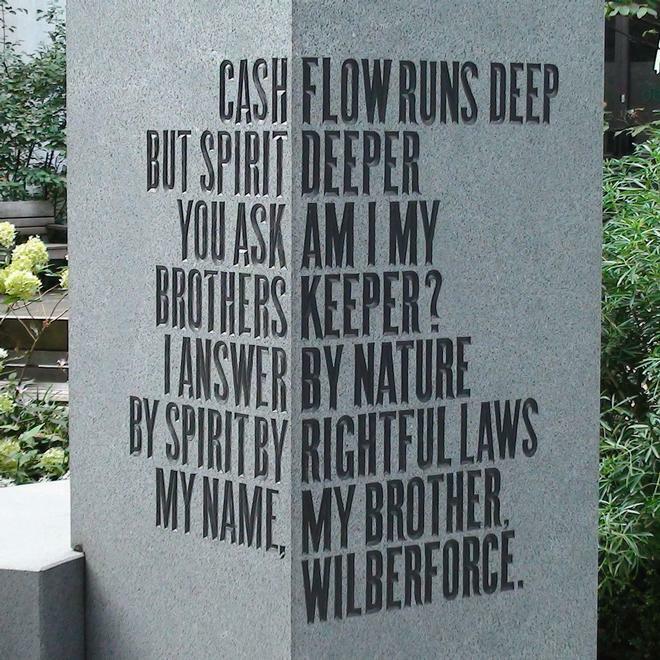Erection date: 4/9/2008
{On a nearby information board:}
Gilt of Cain by Michael Visocchi & Lemn Sissay
This powerful sculpture was unveiled by the Archbishop Emeritus Desmond Mpilo Tutu on 4th September 2008. The sculpture commemorates the abolition of the transatlantic slave trade in 1807, which began the process of the emancipation of slaves throughout the British Empire.
Fen Court is the site of a churchyard formerly of St Gabriel’s Fenchurch St and now in the Parish of St Edmund the King and St Mary Woolnoth, Lombard St. The latter has a strong historical connection with the abolitionist movement of the 18th and 19th centuries. The Rev John Newton, a slave-trader turned preacher and abolitionist, was rector of St Mary Woolnoth from 1780 – 1807. Newton worked closely alongside the famous abolitionist William Wilberforce.
The granite sculpture is composed of a group of columns surrounding a podium. The podium calls to mind an ecclesiastical pulpit or slave auctioneer’s stance, whilst the columns evoke stems of sugar cane and are positioned to suggest an anonymous crowd or congregation gathered to listen to a speaker.
The artwork is the result of a collaboration between sculptor Michael Visocchi and poet Lemn Sissay. Extracts from Lemn Sissay’s poem, ‘Gilt of Cain’, are engraved into the granite. The poem skilfully weaves the coded language of the City’s stock exchange trading floor with biblical Old Testament references.
The Gilt of Cain
By Lemn Sissay, 2007
Here is the ask price on the closed position,
history is no inherent acquisition
for here the Technical Correction upon the act,
a merger of truth and in actual fact
on the spot, on the money – the spread.
The dealer lied when the dealer said
the bull was charging the bear was dead,
the market must calculate per capita, not head.
And great traders acting in concert, arms rise
as the actuals frought on the sea of franchise
thrown overboard into the exchange to drown
in distressed brokers disconsolate frown.
In Accounting liquidity is a mounting morbidity
but raising the arms with such rigid rapidity…
Oh the reaping the raping rapacious fluidity.
the violence the vicious and vexed volatility.
The roaring trade floor rises above crashing waves:
the traders buy ships, beneath the slaves.
Sway machete back, sway machete again
cut back the Sugar Rush, Cain.
The whipsaw it’s all and the whip saw it all
The rising market and the cargo fall
Who’ll enter “Jerusalem” make the margin call for Abel?
Who will kick over the stall and turn the table?
Cain gathers cane as gilt-gift to his land
But whose sword of truth shall not sleep in hand?
Who shall unlock the stocks and share?
Break the bond the bind unbound - lay bare
The Truth. Cash flow runs deep but spirit deeper
You ask Am I my brothers keeper?
I answer by nature by spirit by rightful laws
My name, my brother, Wilberforce.
This project was initiated by Black British Heritage and the Parish of St Mary Woolnoth and was commissioned by the City of London Corporation in partnership with the British Land Company.
{lines from the poem are inscribed on elements of the monument.}
This sculpture, 'Gilt of Cain', was unveiled by Bishop Tutu in commemoration of the bicentenary of the abolition of the transatlantic slave trade in 2007. discusses the iconography used in this artwork (sugar cane, pulpit, slave market).
Site: Gilt of Cain - Slave trade (1 memorial)
EC3, Fen Court
Fen Court was at one time the churchyard of St Gabriel’s Fenchurch.
















Comments are provided by Facebook, please ensure you are signed in to see them